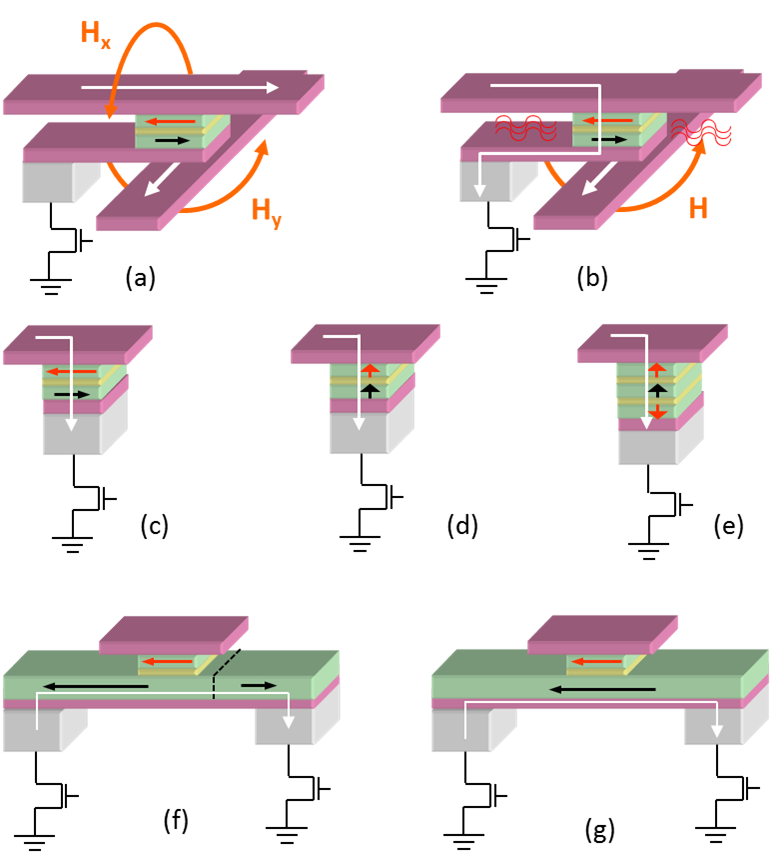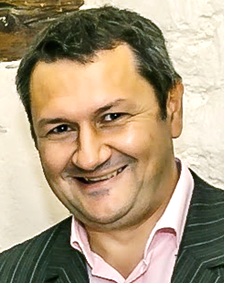Thematic overview
Magnetic Random Access Memories (MRAM) is a non-volatile memory technology, where information is stored by the magnetization direction of magnetic electrodes, very similar to computer hard-disk drives. The goal for MRAM memory is to simultaneously achieve high-speed read/write times, high density and unlimited cycling compared to other existing and emerging technologies.
Our group is developing advanced MRAM cell concepts patented at Spintec. The concepts are based on the use of temperature to reduce power consumption and increase the stability of the stored information. These ideas go beyond the conventional MRAM approach. The naturally occurring temperature increase during the write step is not lost, but is instead used to achieve the seemingly opposing goal of lowering the power consumption and increasing the thermal stability in the operating temperature range. Our group fosters young and experienced researchers developing/applying their expertise in the field of MRAM.

Questions to be addressed
Our main research axis is to use the naturally occurring temperature increase during the write step, when a current flows through the magnetic tunnel junction. The heating is used to go above a temperature threshold, making it possible to write the storage layer magnetization. This principle has been applied to in-plane magnetization cells using a storage layer pinned by an anti-ferromagnet and recently to perpendicular anisotropy cells. Our group’s goal is to demonstrate the proof-of-concept and then improve MRAM cell properties.
Our work involves the development of magnetic material systems, nano-fabrication (20-200nm cells), characterization of devices (magnetic & electrical) and simulation of the device behavior. Our activity in these vast fields is as follows;: On materials research, we are developing magnetic tunnel junctions with in-plane and perpendicular magnetic anisotropy. New electrode stacks having the material properties required by each specific concept need to be integrated in magnetic tunnel junctions, while achieving high levels of TMR signal. For the characterization of each concept we determine the write window parameters in terms of magnetic field, power consumption and magnetization reversal dynamics. Macrospin and micromagnetic simulation provide a better physical understanding of the system properties and the possibilities for optimization.
Projects
ANR EXCALYB – Perpendicular Anisotropy Materials for High-Density Non-volatile Magnetic Memory Cells
Crocus R&D – Thermally assisted MRAM
Samsung SGMI
Partners
Crocus Technology
Institut Néel
SP2M/NM
SAMSUNG
Applied Materials
SINGULUS
Recent news
- Jean-Pierre Nozières rewarded with the CNRS Innovation Medal 2017 [August 21st, 2017]
The medal of innovation of CNRS is granted yearly to one or a few persons having conducted ground-breaking research, which led to key innovation in technology, life or social sectors. Since 2011, this distinction has ... - 1 year post-doc position : Development of electric field assisted STT-MRAMs [July 25th, 2017]
In the frame of our ELECSPIN ANR project , we have an open position for a 12 months post-doc position. ELECSPIN project aims at developing spintronics devices based on manipulating magnetic properties by an electric ... - Seminar : Neuromorphic computing : From a memristive device to the learning process [July 05th, 2017]
on July, 12th, 14H, Steven Lequeux from Spintec, will give a seminar on “Neuromorphic computing : From a memristive device to the learning process”. The seminar will take place in Building 10.05, room 434. In ... - Review – Perpendicular magnetic anisotropy at transition metal/oxide interfaces and applications [June 28th, 2017]
B. Dieny and M. Chshiev, Rev. Mod. Phys. 89, 025008 (2017). Spin electronics is a rapidly expanding field stimulated by a strong synergy between breakthrough basic research discoveries and industrial applications in the fields of magnetic ... - Poster and talk prizes at Intermag Dublin [May 03rd, 2017]
Nearly twenty scientists from SPINTEC participated in Intermag Dublin (24-28 April 2017), among which two thirds were PhD students and post-docs. Paul Noël was awarded a session poster prize (Large and tunable spin Hall angles ...

SOUSA Ricardo
ricardo.sousa@cea.fr

BALTZ Vincent
vincent.baltz@cea.fr

PREJBEANU Lucian
lucian.prejbeanu@cea.fr

DIENY Bernard
bernard.dieny@cea.fr





